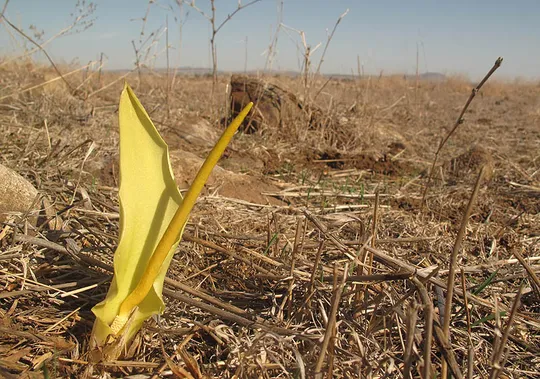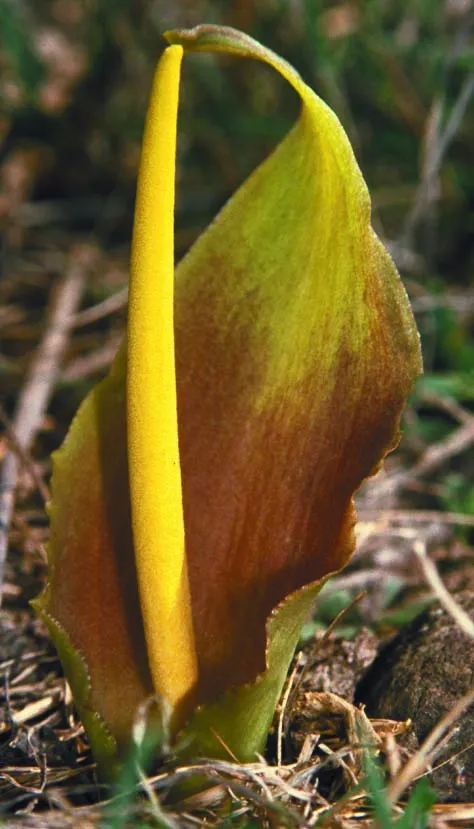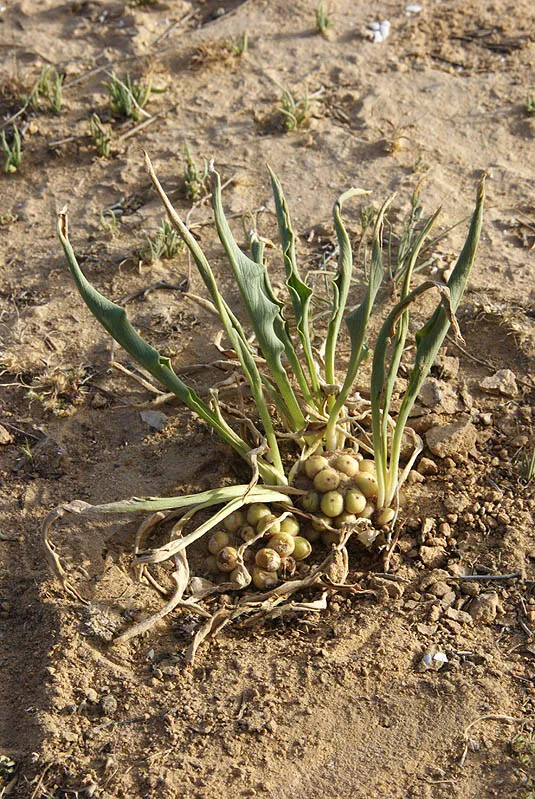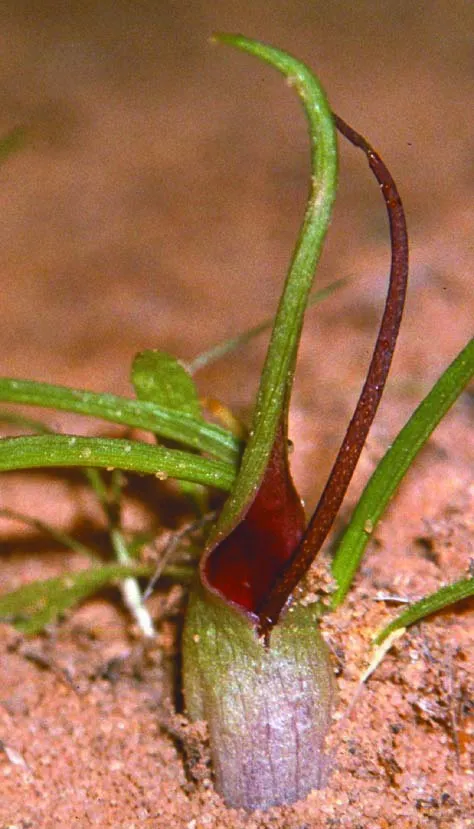Yellow Biarum
Biarum auraniticum


Biarum auranitcum is a geophyte that flowers in autumn without leaves. Its thick, annual tuber is subterranean: every year the winter leaves form new tubers over the shrinking old ones. The large leaves (3.5X 10 cm) appear only in winter, after flowering is complete; they have a distinct petiole and are shiny and hairless. B. auranitcum blooms from late October to mid-November. Its inflorescence is characteristic of the family: a large, dark purple (or yellow) spathe, from which a long yellow (rarely purple) spadix emerges. The female flowers are arranged at the base of the spadix and the male flowers are above them. Between the female and male flowers is a ring of sterile bristle-like flowers, which are important in distinguishing between the different Biarum species. The base of the spathe creates a jug-like tube that envelops the inflorescence.
Ofer Cohen and Aryeh Ohad discovered the plant for the first time in Israel in 1996 in the Golan. It was considered an extremely rare species that grew in only on a few locations in the central Golan. Since then many other sites were found, but all of them in the same 10 sq. km area along 5 km between Ruǧum El-Hiri and Shabanie.
Shallow basalt soil at intermediate depths on flood basalt that forms plateaus covered in large basalt stones, at altitudes above 600 meters.
This is a very close species to Biarum bovei and it may have developed from it. The main difference between the two species is the rachis color (yellow in B. auraniticum and purple B. bovei). Plants whose rachis color was a transition between of the two species were found in the central Golan. The Biarum genus has 15 species with a Mediterranean distribution. In Israel, there are five species, of which, all but one (B. olivierii, found in the Negev sands) grow in the Mediterranean region. Unlike the genus Arum, all the Biarum species bloom in the autumn without leaves. The genus Biarum may be considered an evolutionary branch of the genus Arum in the course of transition to autumn flowering, a feature characteristic of many geophytes in the Mediterranean climate.
• Most of the areas in which the Biarum grows are used for cattle grazing. The cows do not consume Biarum leaves, nor do they eat or trample the autumn blossoms. The only threat factors are the establishment of water reservoirs in the region, road construction and other earthworks and crushing by off-road vehicles (ORV).
• Individual plants grow in patches over extensive areas. The distance between plants is usually 3 to 15 meters, i.e. the distribution pattern is sparse at the local level and patchy at the regional level. All known populations grow in the same geographical area in the section between Shabanie to Ruǧum El-Hiri. On a local level therefore, there is no fragmentation between the populations.
• When the species was first found in Israel in 1997-1998 it was believed that only a few individuals grow in Israel. With time, however, it became clear that thousands of individuals grow on the five kilometers between Shabanie and Ruǧum El-Hiri.
• The plant is endemic to the Golan and to the Ǧebel Druz (Horan).
• The species is not protected in a nature reserve.
Two locations with the greatest density of Biarum auraniticum should be selected and declared a special nature reserve for this key sub-endemic species. Existing populations should be fenced and vehicles prevented from crossing the area.
Described from the Horan (ǧebel Druz) in southern Syria. Endemic to the Horan and to the central Golan.
A geophyte endemic to the Golan and Horan whose preservation is particularly important. A special reserve for this species should be established on the Golan and other sites where it grows should be fenced.
כהן, ע. 1999. גילויו מחדש של אחילוף החורן.
אקולוגיה וסביבה 5: 219–229.
Current Occupancy Map
| 1000 squre meter pixel | 5000 squre meter pixel | 10000 squre meter pixel | |
|---|---|---|---|
| number of observations | 0 | 0 | 0 |
| in total pixels | 0 | 0 | 0 |
| Family | Araceae |
| Classification | On the endangered species list |
| Ecosystem | Semi-Steppe |
| Chorotype | Endemic (Western Irano-Turanian) |
| Conservation Site | Ruǧum El-Hiri |
| Rarity |
1
3
6
|
|---|---|
| Vulnerability |
0
0
4
|
| Attractiveness |
0
0
4
|
| Endemism |
0
3
4
|
| Red number |
1
3.2
10
|
| Peripherality | 0 |
| IUCN category | DD EW EX LC CR EN VU NT |
| Threat Definition according to the red book | Vulnerable |
 Based on:
Based on:






